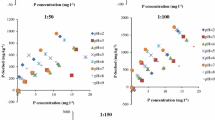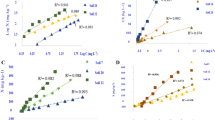Abstract
Five field experiments involving P application rates from 0 to 66 kg P ha−1 were conducted on irrigated wheat at Tandojam, Pakistan. The soils belonged to two great soil groups, Torrifluvent and Camborthid. All soils were calcareous. Olsen-P contents ranged from 3.5 to 6.3 mg P kg−1. Phosphate sorption curves were developed for soils from control (no P) plots at each site. Concentrations of P in solution established by fertilization in the field as estimated from the sorption curves ranged from 0.008 to 0.16mg P L−1. Actual grain yields were converted to relative grain yields and plotted against corresponding concentrations of P in solution. Yield response to P application was obtained in each experiment. Control plot yields ranged from 57 to 89% of maximum yield of respective experiments. Phosphorus requirements of wheat were 0.032 mg L−1 for 95% yield as determined from a composite yield response curve. Predicted quantities of P required to attain 0.032 mg P L−1 ranged from 18 to 29 kg P ha−1. The results of the study suggest that the P sorption approach can be used as a rational basis for making P fertilizer recommendations for various soil-crop combinations.
Similar content being viewed by others
References
Fox RL and Kamprath EJ (1970) Phosphate sorption isotherms for evaluating the phosphate requirements of soils. Soil Sci Soc Am Proc 34: 902–907
Hesse PR (1971) A textbook of soil chemical analysis. John Murrary (Publishers) Ltd., London p 300
Jones JP and Benson JA (1975) Phosphate sorption isotherms for fertilizer P needs of sweet corn (Zea mays) grown on high phosphorus fixing soil. Comm Soil Sci Plant Anal 6: 465–477
Juo ASR and Fox RL (1977) Phosphate sorption capacity of some benchmark soils in West Africa. Soil Sci 134: 370–376
Memon KS (1982) The phosphorus requirements of cereal crops with emphasis on the tropics. PhD thesis, Department of Agronomy and Soil Science, University of Hawaii, Honolulu, Hawaii
Memon KS (1985) Determining phosphorus fertilizer requirements of crops under different soil and agroclimatic conditions. Training Bulletin 6, National Fertilizer Development Centre, Islamabad, 69–76
Memon KS and Fox RL (1983) Utility of phosphate sorption curves in estimating phosphorus requirements of cereal crops: Wheat (Triticum aestivum). Proc Third International Congress on Phosphorus Compounds, Brussels, Belgium, p 217–230
Olsen SR, Cole CV, Watanabe FS and Dean LA (1954) Estimation of available phosphorus in soils by extraction with sodium bicarbonate. USDA Circ 1939
Roy AC and DeDatta SK (1985) Phosphate sorption isotherms for evaluating phosphorus requirement of wetland rice soils. Plant Soil 86: 185–196
Soil Survey Staff (1971) Detailed soil survey of Agricultural Research Institute, Tandojam, Directorate of Soil Survey, Soil Survey Project of Pakistan, Lahore
Vander Zaag P, Fox RL, de la Pena RS, Laughlin WM, Ryskamp A, Villagracia S and Westermann DT (1979) The utility of phosphate sorption curves for transferring soil management information. Trop Agric (Trinidad) 56: 153–160
Author information
Authors and Affiliations
Rights and permissions
About this article
Cite this article
Memon, K.S., Puno, H.K. & Fox, R.L. Phosphate sorption approach for determining phosphorus requirements of wheat in calcareous soils. Fertilizer Research 28, 67–72 (1991). https://doi.org/10.1007/BF01048857
Received:
Accepted:
Issue Date:
DOI: https://doi.org/10.1007/BF01048857




